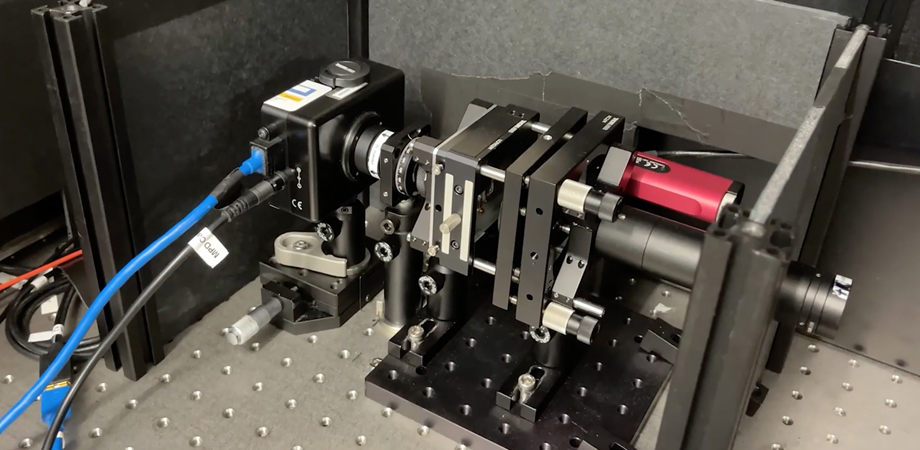Quantum microscope enhances sensitivity — without causing photodamage

European researchers from ICFO, Politecnico di Milano, Micro Photon Devices, Fraunhofer IOF — partners in the "Q-MIC project" — have developed a quantum-enhanced microscope. Since 2018, the European project Q-MIC (q-mic. eu) has been working to develop quantum imaging for microscopy of highly sensitive samples. The results of their work have now been gathered in a recent paper published in Science Advances (science.org/doi/10.1126/sciadv.abj2155).
The team of researchers includes Barcelona, Spain-based research center ICFO scientists Robin Camphausen, Alvaro Cuevas, Luc Duempelmann, Roland Terborg, Ewelina Wajs, led by ICREA Prof. at ICFO Valerio Pruneri, in collaboration with the project partners Simone Tisa and Alessandro Ruggeri from Micro Photon Devices (MPD), Iris Cusini, from Politecnico di Milano and Fabian Steinlechner, from Fraunhofer IOF. They have reported on the results obtained from the new quantum-enhanced microscope that the whole consortium has developed. The scope uses very low intensity levels of light to image large areas of samples, with a higher sensitivity and resolution, compared to classical microscopes.
As Robin Camphausen explains, "the Q-MIC microscope is unique in the sense that it has been designed to actually illuminate the sample using quantum light. Instead of normal light, where many unordered photons reach the sample, our quantum source uses pairs of entangled photons and sends them in small numbers to hit the sample and retrieve information in a more detailed and specific way."
Generally, using low levels of light to avoid damage unfortunately increases the amount of background noise in the measurement and hampers all details and sharpness you can get in an image. "It's just like when the first mobile phone cameras were launched into market. If you tried taking a picture at night, the sharpness of the picture was really bad because not enough photons would be captured to form a clear image so the pixels would look undefined, and also the background lights disturbed the quality of the image," says Camphausen.

Q-MIC researcher Robin Camphausen. Credit: Q-MIC/ICFO
This issue is bypassed with this microscope, because it uses interference patterns of entangled photons to actually reconstruct the image of a sample. Specifically, it integrates a quantum source, which generates space-polarization hyper-entangled "NOON state" photons, a large field of view lens-free interference microscope and a single photon avalanche diode (SPAD) array camera.
"The device we built and the technique we have developed actually uses the entanglement of photons to enhance the interference patterns obtained in the imaging process, and because of this quantum effect, we are able to reduce the noise level and increase the sensitivity of the measurements by more than 25% when compared to classical measurements," comments fellow researcher Alvaro Cuevas, a co-author of the Science Advances paper. In doing so, what the camera registers are not optical intensities nor single photon counts, but actually two-photon coincidences across the entire field of view. When the pairs of photons go through the device, a set of Savart plates divides them into two paths, and guides them to the sample. If the sample is flat, the path of the photons will be the same, but if the sample has different thicknesses, the individual paths of the photons change and an interference pattern is created on the detector. By repeating this process of sending in photons, the researchers obtain an interference pattern image without the need of a pixel-to-pixel scanning system. And with the help of mathematical algorithms, they can reconstruct the image to find more details in the sample itself.
Testing with Protein A
To confirm such improvement in the results, the researchers took a standard diagnostic solution made of a sample of Protein A, a reference material used as a calibration tool. The proteins were deposited onto a glass slide, equally spaced out, and then the sample was mounted on a sample holder inside the microscope. Firstly, the sample was initially illuminated with classical light and then with quantum light; secondly, the respective interference patterns were obtained, and, finally, the images reconstructed. What they saw is that the quantum technique retrieves a much smoother image when compared to the classical one.

Q-MIC researcher Alvaro Cuevas. Credit: Q-MIC/ICFO
Even though the quantum image was reconstructed using fewer photons than the classical one, the smoothness of the image was much cleaner. Cuevas summarizes this as follows: "when we refer to smoothness, it means that if you take an image of a flat surface with low intensity classical light, the level of noise seen in the image is due to the randomness in the level of the data, basically the noise that comes from all the discrete disordered photons that constitute this type of light. With quantum light, the noise level and thus the randomness is reduced, so you get better information about sharp edges, which, in the end, is essential for recognizing concentrations, depths, heights of the samples."
The team says the results are "very promising and enable a completely new way of implementing quantum imaging in everyday sensing and imaging technology." As Valerio Pruneri, coordinator of the project, concludes, "this innovative device has the potential to become an everyday tool used at large. It shows amazing capabilities that can definitely be exploited in several applications, ranging from material sciences, analyzing transparent surfaces for quality assurance in flexible electronics, to quantum cryptography for secure communications or ultra-sensitive imaging of micro-organisms, viruses, and molecules, just to mention a few. Quantum-enhanced microscopy could become a game-changer in the world of microscopy."
Matthew Peach is editor-in-chief of optics.org and director of Original Content Ltd. A version of this article appeared in the 2022 Photonics West Show Daily.
| Enjoy this article? Get similar news in your inbox |
|



